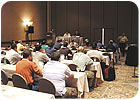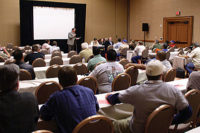
In terms of education in the stone industry, it seems the one area that is a bit lacking is information on perfecting countertop installations and unexpected issues on the jobsite. With this in mind, the “Installer Forums” that take place at StonExpo are particularly lively, as attendees are able to discuss their problems and experiences with fellow countertop installers. The most recent session was presented by Mark Lauzon of Stoneworks in Hubbard, OR, and Jim Isaminger and Terry Isaminger of DMI Tile and Marble, Inc. of Birmingham, AL.
The following is a summary of the topics that were discussed at the session:
How important is it to determine the costs of an installation - shop drawing costs; template costs; tool costs; transportation costs; hourly versus subcontractor labor?
The majority of attendees said they are considering their installation costs, although several fabricators said they don’t have the time to deal with these issues. “I’m just happy when I get paid,” stated one member of the audience.
Lauzon said that while job costing doesn’t usually hold a high priority for smaller, start-up shops, it becomes “extremely important as you grow.” “Some of the costs shocked us; like paying $1,100 just to haul waste granite to the dump,” he said.
Jim Isaminger agreed that with increased production rates, it is critical to “know your budget on the front end. You need to know what you will see at the end of the month.”
“You have to see the finish before you start,” Terry Isaminger added. “For example, look at your transportation costs and the price of fuel today. That is an issue that must be accounted for, because you’re talking about price increases of thousands of dollars.”
More specific to actual installation costs, how do you determine what to charge your customers, and how to document these charges when billing a customer?
“The size of the components is a major factor,” Lauzon explained. “We have a spreadsheet that calculates the weight of the pieces. This helps us understand how many people we will need to send to the house. We know up front if we will have to include an ‘add-man’ charge, and this comes up when we’re doing our bidding. We also include a ‘corner charge,’ because the basic square-foot charges don’t always make sense. Any ‘touch’ should be factored into the quote.”
Offering an alternative view on this concept, one of the fabricators present in the audience said that increased competition - especially from low-end, low-priced shops - has made it extremely difficult to charge “add-ons.”
The fabricators on hand at the forum generally agreed that these charges are difficult to implement when going after the lower-end customers, but they felt it was feasible when working on high-end homes. “Rather than lower prices, we have worked to change our market,” Lauzon said. “We’re not working on spec homes, and we’re doing more remodeling work. We’re doing tear-outs for these customers, and we charge $600 or $700 for that work. We’ll also make tile backsplashes for these customers.”
Are installation crews masking off the work area?
Only a few of the fabricators who attended the session said that they’re masking off the work area, but Lauzon said that doing so was a simple way to earn points with the homeowner. “You do the masking in a few steps, and you’re showing respect for their home,” he said. “This is what will help get you referrals, because your competition is not doing that.”
Terry Isaminger, whose company does mask off the work area, did caution that this step - including materials and labor - needs to be considered when pricing a job. “Whatever you do, you’d better have it in your costs,” he said.
What is the fabricator’s responsibility after the countertop is installed?
One concern raised by the panel was the fact that other tradesmen can damage the finished countertops after they are installed. “Once the tops are installed, they become a workspace for the painters, the electricians, etc.,” said Terry Isaminger. To help offset this, his company adheres official signage on the installed countertops - stating “Do not stand” in English and in Spanish. “It may not always get them to stop doing it, but it covers you and shows that this is a concern,” Jim Isaminger said.
The panelists also said that they place a static sticker on the finished countertop with the company contact information, maintenance contact information and name of the head installer/quality inspector. “This is valuable, because the installer now takes ownership of it; they are taking responsibility for their work,” Lauzon said.
How many fabricators are using “installation checklists” to follow and sign after the work is complete?
Only a minority of the fabricators on hand said they are utilizing checklists, although Lauzon said he not only uses installation checklists, but also template checklists. “They matter; they’re easy to make and cheap to implement.”
Jim Isaminger said that his company uses a 15-point checklist that is printed on three-fold carbon copy paper, and the customer must sign it after the job is completed. “This is something concrete that says the customer has gone over everything, and they approve the work that has been done.”
In general, the panelists said that tools such as checklists help increase the dialogue on a project. “It starts with the point of sale,” said Terry Isaminger. “In the stone business, it is my responsibility to educate the customer. Our job proposal is five pages, and it outlines all of the common concerns that have to do with granite.”
Lauzon agreed that establishing accurate customer expectations at the point of sale will help avoid misunderstanding over the course of a project. “We set the expectations at the sales point; we explain basic issues such as fissures in certain stones,” he said. “This goes both ways, because you can sense who will be the difficult customers where you need to send your top people or the owner.”
Both Lauzon and the Isamingers said that taking photos of the completed job also helps to resolve disputes down the road. “Sometimes you have to stand up for your work and stand up for yourself,” Terry Isaminger said.
Are fabricators requiring the homeowner to be present during templating?
About half of the fabricators present at the session said that they require the homeowner or builder to be present during the templating stage, and this underscores the importance of templating in general. “We pay the most to our templaters,” said Terry Isaminger. “And with digital templating, it shows an added level of professionalism.”
What are fabricators doing when a problem with a countertop installation results in non-payment?
One example presented was a case where the wallpaper contractors broke the countertop, and the customer pulled their payment. In these types of disputes, Terry Isaminger said that it is necessary to actually “see the customer in person - eyeball to eyeball. You have to settle these matters in person and not with a phone call or letters.”
Lauzon said that all of his contracts include a note that the customer will be responsible for any fees associated with collection. “The threat of litigation is great,” he said.
Terry Isaminger agreed that this is the formula for many larger companies - such as Home Depot - that require a full credit application. “Part of business is to protect yourself, and the customer respects a good businessperson,” he said. “In today’s world, you can’t do business on a handshake anymore. You need a contract in case there is a problem.”

